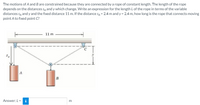
College Physics
11th Edition
ISBN: 9781305952300
Author: Raymond A. Serway, Chris Vuille
Publisher: Cengage Learning
expand_more
expand_more
format_list_bulleted
Concept explainers
Question

Transcribed Image Text:The motions of A and B are constrained because they are connected by a rope of constant length. The length of the rope
depends on the distances sĄ andy which change. Write an expression for the length L of the rope in terms of the variable
distances sĄ and y and the fixed distance 11 m. If the distance sA = 2.4 m and y = 2.4 m, how long is the rope that connects moving
point A to fixed point C?
11 m
Answer:L =
i

Transcribed Image Text:The distance y = 2.4 m. Find the upward velocity of A if the downward velocity of B is 4.1 m/s. Neglect the diameters of the pulleys.
11 m
A
B
Expert Solution
This question has been solved!
Explore an expertly crafted, step-by-step solution for a thorough understanding of key concepts.
This is a popular solution
Trending nowThis is a popular solution!
Step by stepSolved in 2 steps with 2 images

Knowledge Booster
Learn more about
Need a deep-dive on the concept behind this application? Look no further. Learn more about this topic, physics and related others by exploring similar questions and additional content below.Similar questions
- Consider the motion described by the figure below. (a) Find the displacement at t = 12.4 s(b) Find the displacement at t = 12.9 s(c) Find the displacement at t = 16.5 sarrow_forwardAn experimentalist in a laboratory finds that a particle has a helical path. The position of this particle in the laboratory frme is given by r(t)= R cos(wt)i + R sin(wt)j + vztk R,vz, and w are constants. A moving frame has velocity (Vm)L= vzk relative to the laboratory frame. In vector form: A)What is the path of the partical in the moving frame? B)what is the velocity of the particle as a function of time relative to the moving frame? C)What is the acceleration of the particle in each frame? D)How should the accelerartion in each frame be realted?Does your answer to part c make sense?arrow_forwardThe velocity of a particle is given by v = 29t²-88t - 196, where v is in feet per second and t is in seconds. Plot the velocity v and acceleration a versus time for the first 4 seconds of motion. After you have the plots, answer the questions as a check on your work. -1 Questions: + 0 + 1 When t = 0.5 sec, V = 2 i When t = 3.3 sec, V = i + 3 +s, ft or m When the acceleration is zero, the velocity is i ft/sec, a = ft/sec, a = i i ft/sec. ft/sec² ft/sec²arrow_forward
- A cube with the dimensions bXbXb with mass m lies on the flat horizontal ground. One the side shown in the figure. The thickness normal to the plane of the figure is b. The cube is subject to the earth's gravity and the friction coefficient between the cube abd the ground is mu. Express your answer in terms of the given variables. What is the minimum force required to produce sliding? What is the minumum force required to produce tipping of the cube? Assume the cube is rotating about O. Impulsive horizontal loading L is applied on the edge B such that force F(t) is applied during the very short time delta t: where L= the integral from zero to delta t of F(t)dt. What is the minimum value of the impulse for which the cube tips over and falls on side OA.arrow_forwardPart (a) Do this for the range r > R. E = _____ Part (b) Do this for the range r < R. E = _____arrow_forwardUsing the results from part (c), what was the cars horizontal component of acceleration, in meter per second squared, during the braking period ? C=2.75arrow_forward
- Please answer the correctly and clearlyarrow_forwardI need help with a math question: Given that x = position, v = velocity, a = acceleration, m = mass. Which of the following will have units of kg * m/s^2 and why? m ∫ a dt m ∫ v dt 1/2m dv^2/dx m ∫ x dt 1/2m dv^2/dt m dx/dt m dv/dt m da/dt 1/2m ∫ v^2 dt I am including an image/reference table. Thanks!arrow_forward
arrow_back_ios
arrow_forward_ios
Recommended textbooks for you
 College PhysicsPhysicsISBN:9781305952300Author:Raymond A. Serway, Chris VuillePublisher:Cengage Learning
College PhysicsPhysicsISBN:9781305952300Author:Raymond A. Serway, Chris VuillePublisher:Cengage Learning University Physics (14th Edition)PhysicsISBN:9780133969290Author:Hugh D. Young, Roger A. FreedmanPublisher:PEARSON
University Physics (14th Edition)PhysicsISBN:9780133969290Author:Hugh D. Young, Roger A. FreedmanPublisher:PEARSON Introduction To Quantum MechanicsPhysicsISBN:9781107189638Author:Griffiths, David J., Schroeter, Darrell F.Publisher:Cambridge University Press
Introduction To Quantum MechanicsPhysicsISBN:9781107189638Author:Griffiths, David J., Schroeter, Darrell F.Publisher:Cambridge University Press Physics for Scientists and EngineersPhysicsISBN:9781337553278Author:Raymond A. Serway, John W. JewettPublisher:Cengage Learning
Physics for Scientists and EngineersPhysicsISBN:9781337553278Author:Raymond A. Serway, John W. JewettPublisher:Cengage Learning Lecture- Tutorials for Introductory AstronomyPhysicsISBN:9780321820464Author:Edward E. Prather, Tim P. Slater, Jeff P. Adams, Gina BrissendenPublisher:Addison-Wesley
Lecture- Tutorials for Introductory AstronomyPhysicsISBN:9780321820464Author:Edward E. Prather, Tim P. Slater, Jeff P. Adams, Gina BrissendenPublisher:Addison-Wesley College Physics: A Strategic Approach (4th Editio...PhysicsISBN:9780134609034Author:Randall D. Knight (Professor Emeritus), Brian Jones, Stuart FieldPublisher:PEARSON
College Physics: A Strategic Approach (4th Editio...PhysicsISBN:9780134609034Author:Randall D. Knight (Professor Emeritus), Brian Jones, Stuart FieldPublisher:PEARSON

College Physics
Physics
ISBN:9781305952300
Author:Raymond A. Serway, Chris Vuille
Publisher:Cengage Learning

University Physics (14th Edition)
Physics
ISBN:9780133969290
Author:Hugh D. Young, Roger A. Freedman
Publisher:PEARSON

Introduction To Quantum Mechanics
Physics
ISBN:9781107189638
Author:Griffiths, David J., Schroeter, Darrell F.
Publisher:Cambridge University Press

Physics for Scientists and Engineers
Physics
ISBN:9781337553278
Author:Raymond A. Serway, John W. Jewett
Publisher:Cengage Learning

Lecture- Tutorials for Introductory Astronomy
Physics
ISBN:9780321820464
Author:Edward E. Prather, Tim P. Slater, Jeff P. Adams, Gina Brissenden
Publisher:Addison-Wesley

College Physics: A Strategic Approach (4th Editio...
Physics
ISBN:9780134609034
Author:Randall D. Knight (Professor Emeritus), Brian Jones, Stuart Field
Publisher:PEARSON